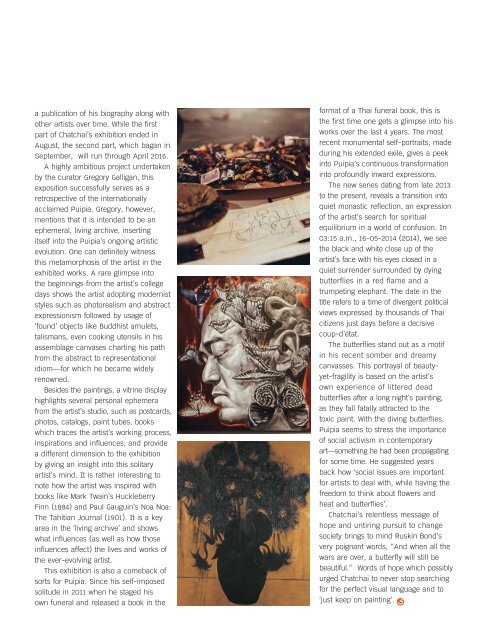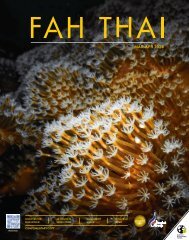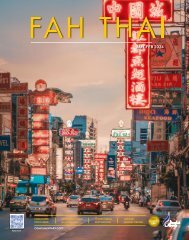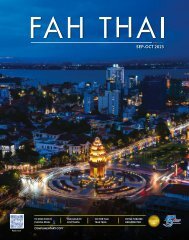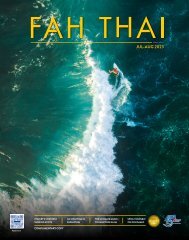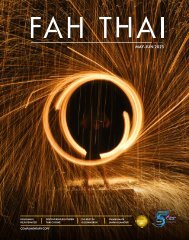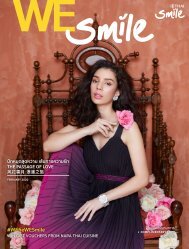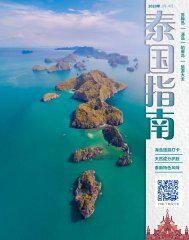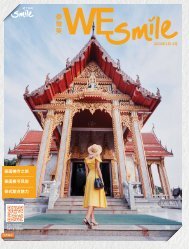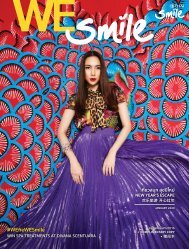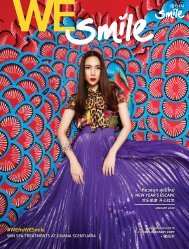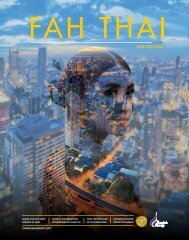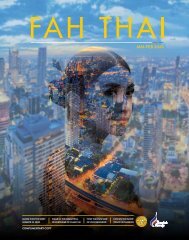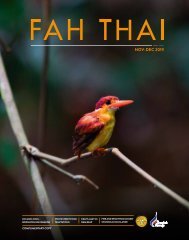WE Smile Magazine October 2015
The In-Flight Magazine of Thai Smile Airways
The In-Flight Magazine of Thai Smile Airways
You also want an ePaper? Increase the reach of your titles
YUMPU automatically turns print PDFs into web optimized ePapers that Google loves.
a publication of his biography along with<br />
other artists over time. While the first<br />
part of Chatchai’s exhibition ended in<br />
August, the second part, which bagan in<br />
September, will run through April 2016.<br />
A highly ambitious project undertaken<br />
by the curator Gregory Galligan, this<br />
exposition successfully serves as a<br />
retrospective of the internationally<br />
acclaimed Puipia. Gregory, however,<br />
mentions that it is intended to be an<br />
ephemeral, living archive, inserting<br />
itself into the Puipia’s ongoing artistic<br />
evolution. One can definitely witness<br />
this metamorphosis of the artist in the<br />
exhibited works. A rare glimpse into<br />
the beginnings from the artist’s college<br />
days shows the artist adopting modernist<br />
styles such as photorealism and abstract<br />
expressionism followed by usage of<br />
‘found’ objects like Buddhist amulets,<br />
talismans, even cooking utensils in his<br />
assemblage canvases charting his path<br />
from the abstract to representational<br />
idiom—for which he became widely<br />
renowned.<br />
Besides the paintings, a vitrine display<br />
highlights several personal ephemera<br />
from the artist’s studio, such as postcards,<br />
photos, catalogs, paint tubes, books<br />
which traces the artist’s working process,<br />
inspirations and influences, and provide<br />
a different dimension to the exhibition<br />
by giving an insight into this solitary<br />
artist’s mind. It is rather interesting to<br />
note how the artist was inspired with<br />
books like Mark Twain’s Huckleberry<br />
Finn (1884) and Paul Gauguin’s Noa Noa:<br />
The Tahitian Journal (1901). It is a key<br />
area in the ‘living archive’ and shows<br />
what influences (as well as how those<br />
influences affect) the lives and works of<br />
the ever-evolving artist.<br />
This exhibition is also a comeback of<br />
sorts for Puipia. Since his self-imposed<br />
solitude in 2011 when he staged his<br />
own funeral and released a book in the<br />
format of a Thai funeral book, this is<br />
the first time one gets a glimpse into his<br />
works over the last 4 years. The most<br />
recent monumental self-portraits, made<br />
during his extended exile, gives a peek<br />
into Puipia’s continuous transformation<br />
into profoundly inward expressions.<br />
The new series dating from late 2013<br />
to the present, reveals a transition into<br />
quiet monastic reflection, an expression<br />
of the artist’s search for spiritual<br />
equilibrium in a world of confusion. In<br />
03:15 a.m., 16-05-2014 (2014), we see<br />
the black and white close up of the<br />
artist’s face with his eyes closed in a<br />
quiet surrender surrounded by dying<br />
butterflies in a red flame and a<br />
trumpeting elephant. The date in the<br />
title refers to a time of divergent political<br />
views expressed by thousands of Thai<br />
citizens just days before a decisive<br />
coup-d’état.<br />
The butterflies stand out as a motif<br />
in his recent somber and dreamy<br />
canvasses. This portrayal of beautyyet-fragility<br />
is based on the artist’s<br />
own experience of littered dead<br />
butterflies after a long night’s painting,<br />
as they fall fatally attracted to the<br />
toxic paint. With the diving butterflies,<br />
Puipia seems to stress the importance<br />
of social activism in contemporary<br />
art—something he had been propagating<br />
for some time. He suggested years<br />
back how ‘social issues are important<br />
for artists to deal with, while having the<br />
freedom to think about flowers and<br />
heat and butterflies’.<br />
Chatchai’s relentless message of<br />
hope and untiring pursuit to change<br />
society brings to mind Ruskin Bond’s<br />
very poignant words, “And when all the<br />
wars are over, a butterfly will still be<br />
beautiful.” Words of hope which possibly<br />
urged Chatchai to never stop searching<br />
for the perfect visual language and to<br />
‘just keep on painting’.


